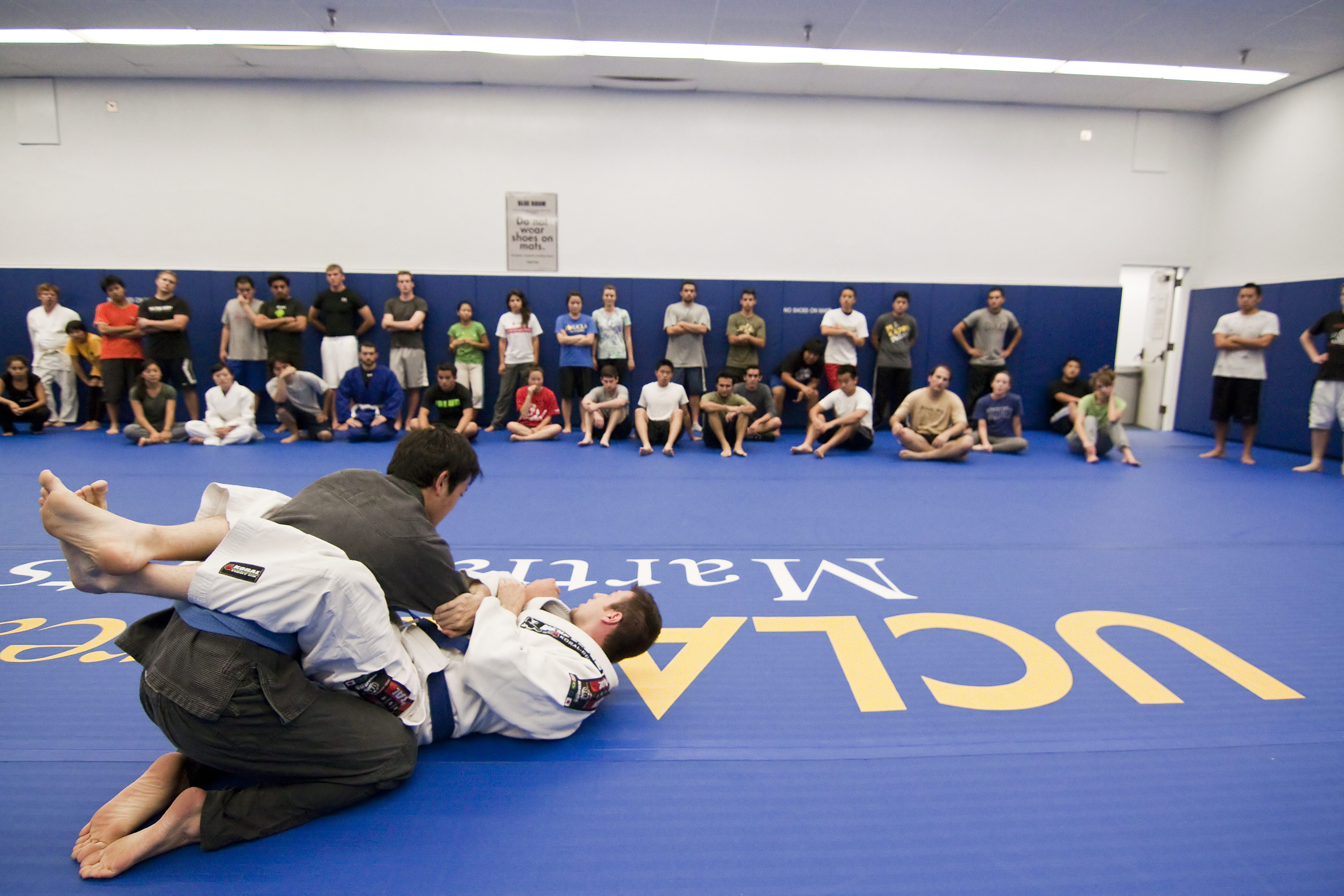Brazilian Jiu-Jitsu gains popularity and becomes a club sport

Members of UCLA’s Brazilian Jiu-Jitsu Club practice in the Wooden Center’s Blue Room on Monday. The club practices five days a week with beginner and intermediate classes available. The classes have seen an increase in participants, and the club has grown in popularity as a result of Jiu Jitsu’s influence in Mixed Martial Arts and the Ultimate Fighting Championship.
By Jason Wang
Oct. 13, 2010 1:11 a.m.
Dave Bryant gave his students two minutes to escape from their opponents’ side control, a dominant grappling position where the combatant has his opponent pinned down and locked perpendicularly.
More than 20 pairs of students lay intertwined on the Wooden Center’s Blue Room floor, ready for Bryant’s signal. What then ensued was a combative struggle, but not a futile one: For two minutes, students matched move for move with their opponents in an attempt to pin the other.
This was human chess. This was Brazilian Jiu-Jitsu.
The very first line of UCLA’s newly-officiated BJJ club’s statement reads that the sport resembles a game of chess. Bryant, the instructor of UCLA’s BJJ club, spends practice time going over moves and techniques to get in and out of various holds and chokes. During the brief drill, students did not attempt to out-muscle their opponents, but instead focused on outmaneuvering them.
“Strength does not matter that much; it’s all about technique,” said Do Hun Kim, a third-year mechanical engineering student and the club’s president. “Momentum, leverage, balance … those override muscle, power and weight advantages.”
As implied by the name, BJJ is derived from Jiu-Jitsu, the ancient Japanese martial art. In the 1930s, Brazilian martial artist Helio Gracie took certain moves from Japanese Jiu-Jitsu and attempted to make the sport more efficient.
Many original Jiu-Jitsu moves were not picked up by Gracie since he could not perform them because of his smaller frame. Technique was the key to success in Gracie Jiu-Jitsu, the other common name for Brazilian Jiu-Jitsu.
Much like how a pawn can overtake a king or queen, a smaller combatant can be successful against a much larger opponent in Brazilian Jiu-Jitsu. One of the reasons why Kim decided to learn BJJ was the appeal of the sport’s David versus Goliath possibility.
“That was always amazing for me,” said Kim. “To see a small 150-pound guy take down a muscular 200-pound guy so gracefully and make that submit. … That’s why I decided to do it.”
For many, the appeal of BJJ’s influence on the ever-growing Mixed Martial Arts scene was the reason for learning the sport.
Danielle Layous, a fourth-year Global Studies student, has been practicing with the group since before it attained official club status. Layous’ interest in mixed martial arts stemmed from watching Ultimate Fighting Championship and it’s first tournament, UFC 1, which was won by fighter Royce Gracie, Helio Gracie’s son.
But Layous’ decision to learn BJJ instead of other martial arts was the same reason Kim had.
“It’s the martial art that emphasizes that a smaller, faster fighter can overpower a larger opponent with the right technique and skill,” said Layous.
But tipping the proverbial scales of combat does not come quickly. The members of the BJJ club put in many hours of practice per week. In addition to open hours in the Wooden Center’s Blue Room, the club practices five days a week and has classes for beginner and intermediate members.
“You have to learn the basics of technique before you spar,” said Layous, who mentioned that ill-preparedness will lead to domination by the opponent. Kim, who said his first year of practicing BJJ led to many submissions, is quick to agree.
“It takes a long time to learn … it can be frustrating,” Kim said. “But once you start getting those techniques down, it really works.”
The club members are in good hands under the instruction of Bryant and black belt Jimmy Tang, who runs the intermediate classes on Tuesdays and Thursdays. Bryant has been practicing martial arts since he was six and picked up Brazilian Jiu-Jitsu in 2001. Tang, who also began in 2001, is a well-known coach and instructor who taught at the world famous Inosanto Academy in Marina del Rey before coming to UCLA. The instructors have been successful in helping the group grow during the past year.
“The classes have really boomed,” said Bryant. “It took a couple years, but word-of-mouth has been spreading. The last year has absolutely exploded, with class sizes growing from 20 to 50. (The Wooden Center) had to expand the mats an extra eight feet to accommodate us.”
The popularity of the sport and MMA, coupled with the accessibility of practice areas and times, helped the club develop.
Daniel Yeh, a fourth-year electrical engineering student who has been doing Brazilian Jiu-Jitsu for more than a year, decided to join the club this year.
“I would always hear from people that the classes were always full,” Yeh said.
Much of the talk about the club has been praise about the atmosphere. During practice, the members are active and vocal, helping each other by addressing strengths and weaknesses. The environment is not strict, but students are serious about learning.
“It’s very laid back, and coach Dave is a really good teacher that encourages us,” Yeh said. “It’s great because you’re comfortable, and you can learn.”
The club is open to students of all levels. Though the sport is about dominating opponents, members are quick to help newcomers. Advanced members tone down their skill level to help less experienced ones.
“New members will feel welcome,” said Kim. “We help them learn, show them moves, and help them get a good workout.”
Now that the club is an official UCLA club, its members wish to help promote the sport itself, as well as plan for collegiate competition and tournaments. But the main goal of teaching correct Brazilian Jiu-Jitsu technique still holds, even if a rear choke hold doesn’t.


